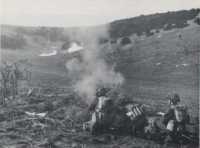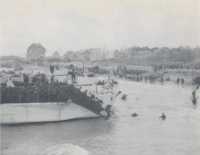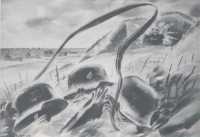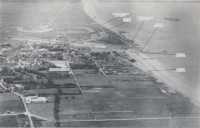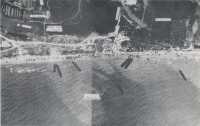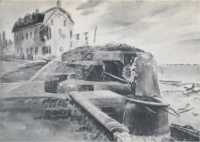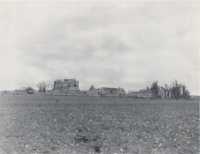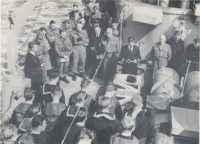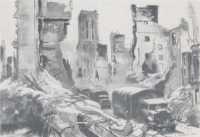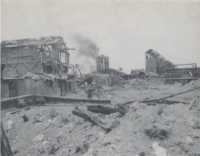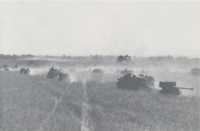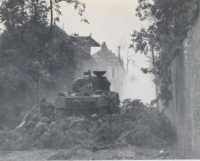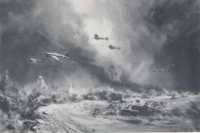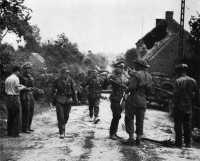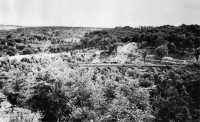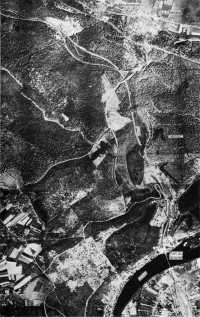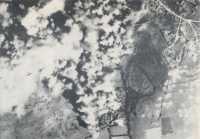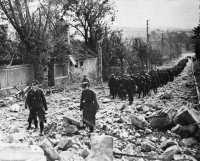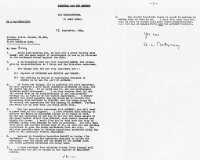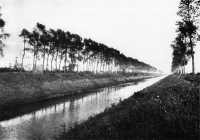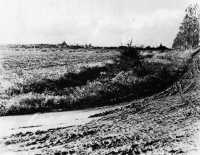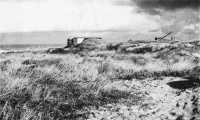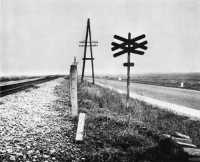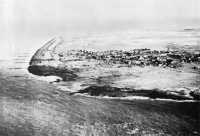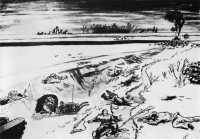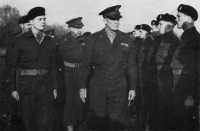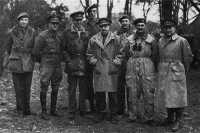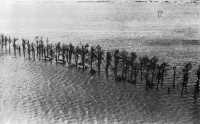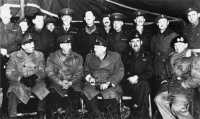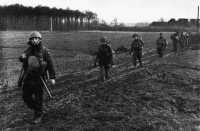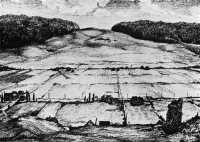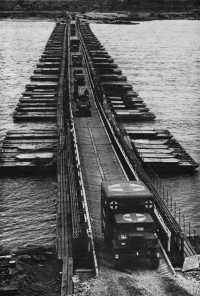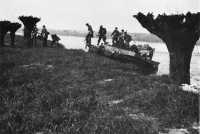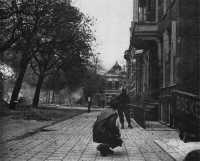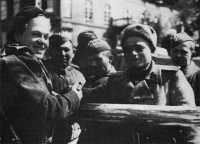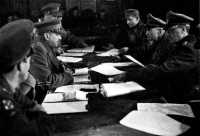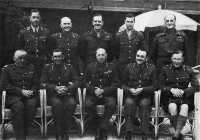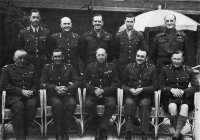Illustrations
Distinguished Observers at Exercise TROUSERS, 12 April 1944. On the beach at Slapton Sands, Devon, From left to right in the foreground, Admiral Ramsay; Brigadier H. W. Foster; Admiral Vian; General Montgomery; and General Dempsey.
Infantrymen of the Assault Force in Training, 18 April 1944. Firing over their comrades’ heads, men of The Regina Rifle Regiment use a 2-inch mortar to lay smoke during an exercise on the Downs north of Southampton.
The Royal Canadian Navy Lands the 9th Brigade. Men of The Stormont, Dunndas and Glengarry Highlanders landing at Bernières-sur-Mer on the morning of D Day. Note the bicycles.
The Broken Atlantic Wall. This watercolour by Capt. O. N. Fisher represents a typical German gun-position on the Normandy beaches. It is one of the casemates on the beach west of Courseulles.
Courseulles From the Air. Although this photograph was taken in 1948, the major German positions assaulted by the 7th Canadian Infantry Brigade on 6 June 1944 still existed and are indicated on the face of the photograph. (Courtesy US Department of the Army)
Congestion on MIKE RED Beach, D Day. These air photographs, taken at an unspecified time near high tide on the morning of 6 June, illustrate the congestion on the beach just west of the River Seulles which resulted from difficulties with the single exit over the flooded area beyond the beach.
Strongpoint at St. Aubin-Sur-Mer. The 50-mm. anti-tank gun in the “resistance nets” attacked by The North Shore (New Brunswick) Regiment on D Day. This gun was fought with determination and gave much trouble. From a watercolour by Capt. O. N. Fisher.
The Abbey of Ardenne. The loft chapel served as an observation post for Kurt Meyer on 7 June (later General Crerar used it for the same purpose). The Abbey was the scene of fierce fighting on 8 July. Photograph taken in 1946.
Divine Service on Board HMCS Algonquin, 18 June 1944. A scene in the destroyer which carried General Crerar and members of his staff to Normandy. From left to right in the centre foreground, Brigadier A. E. Walford; Brigadier C. C. Mann; Captain F. L. Houghton, RCN; General Stuart; Lt.-Cmdr. D. W. Piers, commanding HMCS Algonquin; General Crerar
Canadian Convoy in Caen. Vehicles of the 2nd Canadian Armoured Brigade Company, RCASC, bringing up supplies to the brigade through the ruined city, July 1944. From a watercolour by Major W. A. Ogilvie.
The Steelworks at Colombelles, 19 July 1944. The scene of fierce fighting during Operation ATLANTIC. The ruins of the steelworks were cleared on the evening of 18 July and during the night that followed.
Forward to the Laison. Through the golden grain and the dust, vehicles of the 3rd Canadian Infantry Division advance towards the start-line for Operation TRACTABLE, 14 August. In the foreground are 6-pounder anti-tank guns towed by carriers.
Clearing Out Snipers in Falaise. Men of Les Fusiliers Mont-Royal follow a tank of the 27th Armoured Regiment (the Sherbrooke Fusiliers Regiment) through the town on 17 August.
The Falaise Gap. The painting by Frank Wootton represents RAF Typhoons harrying the German retirement through the Gap, August 1944. (Courtesy Imperial War Museum, London)
St. Lambert-Sur-Dives, August 1944, Germans surrendering to Major D. V. Curries’ force. Major Currie himself, tired and grimy, appears at the left, pistol in hand. This is as close as we are ever likely to come to a photograph of a man winning the Victoria Cross.
The Railway Y in the Fôret de la Londe, By the time this photograph was taken (1946), an additional railway line (curving into the woods in the background) had been built, evidently to by-pass the demolished bridge. The picture was taken looking west from the east side of the valley. The South Saskatchewan Regiment suffered heavily in fighting hereabouts on 28 August 1944.
The Fôret de la Londe, This mosaic, composed of air photographs taken on 24 May 1944, illustrates the 2nd Canadian Division’s battlefield of 27–29 August 1944. The railway lines running from top to bottom indicate the course of the valley which proved such a serious obstacle. See also Map 6.
Lancasters over Mont Lambert, 17 September 1944, A glimpse from above of the heavy attack made by the RAF Bomber Command to prepare the way for the assault by the 3rd Canadian Infantry Division on the defences of Boulogne
German Prisoners at Boulogne, The 400 Germans captured in the underground passages of the Herqulingue hill (the “bargain basement”) march into Boulogne, 21 September 1944
A Letter from the C-in-C, Field-Marshal Montgomery’s letter to General Crerar referring to the forthcoming Arnhem operation and expressing the hope that First Canadian Army can open Antwerp and clear the Channel Ports simultaneously.
The Leopold Canal, Looking East, 1946. On this reach the units of the 7th Canadian Infantry Brigade made their assault crossing in the morning of 6 October 1944. The bridge in the background in near Ooosthoek.
Biervliet From the East, 1946, This is the area where the 9th Canadian Infantry Brigade fought following its landing in the rear of the Breskens Pocket on 9 October 1944.
Atlantic Wall Defences Near Cadzand, The gun at the right, capable of all-round traverse, could be used against Canadian troops on the Leopold Canal and elsewhere in the Breskens Pocket. The Walcheren coastline is on the horizon, across the mouth of the Scheldt. Photograph taken in 1946.
The Walcheren Causeway, Looking East Towards South Beveland, This picture was taken in the autumn of 1946 (at low tide). What appears to be a grassy field at the right is actually weed-grown mud.
The Scene of the Westkapelle Landing, The west point of Walcheren, photographed from the air on an unrecorded date. The gap in the dyke made by the RAF Bomber Command appears clearly in the left foreground. The village is Westkapelle.
On the Dyke at Kepelsche Veer, January 1945, This sketch by Lieut. A. M. Damer was drawn in consultation with officers who manned the artillery observation posts on the dyke. It is reproduced by permission from Capt. R. A. Spencer’s History of the Fifteenth Canadian Field Regiment.
The Supreme Commander Visits Canadian Troops, General Dwight D. Eisenhower, accompanied by General Crerar, inspects a guard of honor of the 29th Armoured Reconnaissance Regiment (The South Alberta Regiment) at Best, near ‘s-Hertogenbosch, Holland, on 29 November 1944. The guard commander is Capt. K. E. Perrin, killed later in the Rhineland battle.
Commanders in Operation VERITABLE, February 1945, The GOC-in-C. First Canadian Army with corps and divisional commanders, near Cleve, 19 February. From left to right, Brigadier M. Elrington, Acting GOC 53rd (Welsh Division); Major-Genera G. Ivor Thomas, 43rd (Wessex) Division; Lieut.-General Sir Brian Horrocks, 30th Corps; Major-General C. M. Barber, 15th (Scottish) Division; General Crerar; Major-General D. C. Spry, 3rd Canadian Infantry Division; Lieut.-General G. G. Simonds, 2nd Canadian Corps; Major-General A. B. Matthews, 2nd Canadian Infantry Division.
Warfare in the Floods, Amphibious vehicles on the Kranenburg road during Operation VERITABLE, February 1945. This photograph illustrates the conditions under which the 3rd Canadian Infantry Division fought in this operation.
The British Prime Minister Visits First Canadian Army, In the front row of this photograph, taken at Headquarters 2nd Canadian Corps on 4 March 1945, are, from left to right, Field-Marshal Sir Alan Brooke, Chief of the Imperial General Staff; General Crerar; Mr. Churchill; Lieut.-General Simonds; and Field-Marshal Montgomery. In rear are staff officers and heads of services of the 2nd Corps. On the extreme left is Major-General T. G. Rennie, GOC 51st (Highland) Division, who was killed three weeks later.
The Algonquins Moving Up, Men of The Algonquin Regiment moving forward in the Hochwald area, 1 March 1945, in preparation for the fierce struggle in the Gap the following day.
The Hochwald Gap, This drawing by Brigadier G. L. Cassidy, DSO ED, based on sketches made on the spot, represents the scene of the 4th Canadian Armoured Division’s battle of February–March 1945 as seen from the west. It is reproduced by permission from Warpath, Brigadier Cassidy’s history of The Algonquin Regiment.
MELVILLE Bridge Carries Traffic Across the Rhine, This bridge across the Rhine ta Emmerich, completed on 1 April 1945 by the 2nd Canadian Army Troops Engineers, is here seen from the right bank of the river.
The Patricias Cross the Ijssel, Men of Princess Patricia’s Canadian Light Infantry landing from “Buffaloes” of the 79th Armoured Division in Operation CANNONSHOT, 11 April 1945.
House-Clearing in Groningen, 15 April 1945, Men of Les Fusiliers Mont-Royal flushing out Germans during the fighting in the city. The soldier wearing the beret carries a Bren gun. In the background a house burns furiously.
Conquerors Meet on the Baltic, A Canadian soldier of ther 1st Canadian Parachute Battalion shakes hands with a Russian officer at the barrier on the outskirts of Wismar, 4 May 1945.
Surrender of the German Twenty-Fifth Army, At Wageningen on 5 May 1945 Lieut.-General Foulkes (left), GOC 1st Canadian Corps, issues instruction to General Johannes Blaskowitz (second from right), commander of the German forces in the Netherlands. Left foreground, HRH Prince Bernhard.
Senior Commanders, First Canadian Army, Hilversum, 20 May 1945, This photograph was taken on the occasion of the First Canadian Army Victory Parade. From left to right, front row, Major-General S. Maczek, 1st Polish Armoured Division; Lieut.-General G. G. Simonds, 2nd Canadian Corps; General Crerar; Lieut.-General C. Foulkes, 1st Canadian Corps; Major-General B. M. Hoffmeister, 5th Canadian Armoured Division. Back row, Major-General R. H. Keefler, 3rd Canadian Infantry Division; Major-General A. B. Matthews, 2nd Canadian Infantry Division; Major-General H. W. Foster, 1st Canadian Infantry Division; Brigadier R. W. Moncel, Acting GOC 4th Canadian Armoured Division; Major-General S. B. Rawlins, 49th (West Riding) Infantry Division.
Canadians in Berlin, The pipes and drums of The Argyll and Sutherland Highlanders of Canada (Princess Louise’s), which accompanied the Canadian Berlin Battalion, on parade before the Column of Victory, 25 July 1945.

